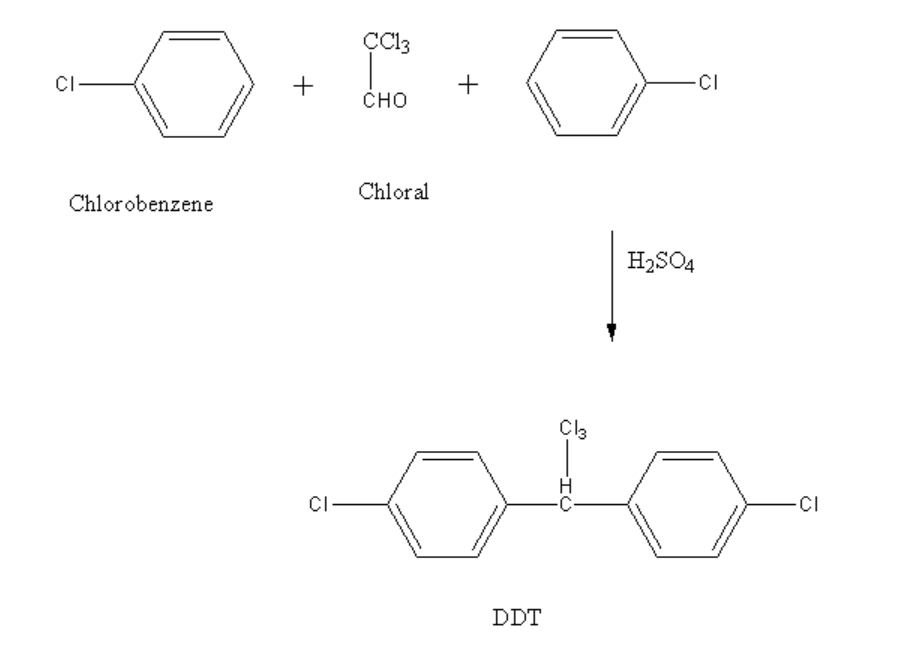
DDT can be prepared by reacting chlorobenzene in the presence of conc.\[{H_2}S{O_4}\] with ______.
Answer
224.4k+ views
Hint: The full form of DDT is dichlorodiphenyltrichloroethane. DDT is a colourless, odourless, tasteless, crystalline chemical compound. The compound to which it reacts is an aldehyde.
Complete Step by Step Solution:
DDT or dichlorodiphenyltrichloroethane is used as an insecticide in agriculture. The chemical formula of DDT is \[{C_{14}}{H_9}C{l_5}\] . The compound is present as a colourless and tasteless crystalline solid in its standard condition for temperature and pressure.
DDT is prepared by reacting chloral and chlorobenzene in presence of concentrated sulphuric acid in a ratio of 1:2.
Chloral is an organic compound having a molecular formula of \[C{l_3}CCHO\]. The other name of chloral is trichloroacetaldehyde or trichloroethanal. It is a colourless oily aldehyde compound which shows solubility in most solvents.
The reaction between chlorobenzene and chloral is shown below.

Image: Preparation of DDT
In the above reaction, two moles of chlorobenzene reacts with one mole of chloral in presence of concentrated sulphuric acid to form dichlorodiphenyltrichloroethane.
Therefore, DDT can be prepared by reacting chlorobenzene in the presence of conc.\[{H_2}S{O_4}\] with chloral.
Additional information: DDT is now banned in different countries as it is a very toxic compound and due to its high usage it leads to death. Chloral on dissolving in water forms chloral hydrate.
Note: Sometimes it may be confusing while drawing the structure of DDT as it is a germinal compound where two benzyl chloride group is attached to one carbon and only one chlorine group is on the other carbon atom.
Complete Step by Step Solution:
DDT or dichlorodiphenyltrichloroethane is used as an insecticide in agriculture. The chemical formula of DDT is \[{C_{14}}{H_9}C{l_5}\] . The compound is present as a colourless and tasteless crystalline solid in its standard condition for temperature and pressure.
DDT is prepared by reacting chloral and chlorobenzene in presence of concentrated sulphuric acid in a ratio of 1:2.
Chloral is an organic compound having a molecular formula of \[C{l_3}CCHO\]. The other name of chloral is trichloroacetaldehyde or trichloroethanal. It is a colourless oily aldehyde compound which shows solubility in most solvents.
The reaction between chlorobenzene and chloral is shown below.

Image: Preparation of DDT
In the above reaction, two moles of chlorobenzene reacts with one mole of chloral in presence of concentrated sulphuric acid to form dichlorodiphenyltrichloroethane.
Therefore, DDT can be prepared by reacting chlorobenzene in the presence of conc.\[{H_2}S{O_4}\] with chloral.
Additional information: DDT is now banned in different countries as it is a very toxic compound and due to its high usage it leads to death. Chloral on dissolving in water forms chloral hydrate.
Note: Sometimes it may be confusing while drawing the structure of DDT as it is a germinal compound where two benzyl chloride group is attached to one carbon and only one chlorine group is on the other carbon atom.
Recently Updated Pages
JEE Main 2026 Session 1 Correction Window Started: Check Dates, Edit Link & Fees

JEE Isolation, Preparation and Properties of Non-metals Important Concepts and Tips for Exam Preparation

Isoelectronic Definition in Chemistry: Meaning, Examples & Trends

Ionisation Energy and Ionisation Potential Explained

Iodoform Reactions - Important Concepts and Tips for JEE

Introduction to Dimensions: Understanding the Basics

Trending doubts
JEE Main 2026: City Intimation Slip and Exam Dates Released, Application Form Closed, Syllabus & Eligibility

JEE Main 2026 Application Login: Direct Link, Registration, Form Fill, and Steps

Understanding the Angle of Deviation in a Prism

How to Convert a Galvanometer into an Ammeter or Voltmeter

Hybridisation in Chemistry – Concept, Types & Applications

Ideal and Non-Ideal Solutions Explained for Class 12 Chemistry

Other Pages
NCERT Solutions For Class 12 Chemistry Chapter 1 Solutions - 2025-26

JEE Advanced Marks vs Ranks 2025: Understanding Category-wise Qualifying Marks and Previous Year Cut-offs

Solutions Class 12 Chemistry Chapter 1 CBSE Notes - 2025-26

NCERT Solutions ForClass 12 Chemistry Chapter Chapter 4 The D and F Block Elements

Biomolecules Class 12 Chemistry Chapter 10 CBSE Notes - 2025-26

NCERT Solutions For Class 12 Chemistry Chapter 10 Biomolecules - 2025-26




